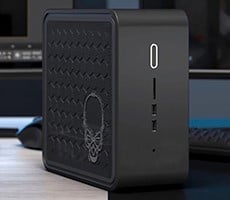Foxconn e-bot Small Form Factor PC
|
For our next round of benchmarks, we ran the CPU and Memory performance modules built-into Futuremark's PCMark04. For those interested in more than just the graphs, we've got a couple of quotes from Futuremark that explain exactly what these tests do and how they work...
"The CPU test suite is a collection of tests that are run to isolate the performance of the CPU. There are nine tests in all. Two pairs of tests are run multithreaded - each test in the pair is run in its own thread. The remaining five tests are run single threaded. These tests include such functions as file encryption, decryption, compression and decompression, grammar check, audio conversion, WMV and DivX video compression."

While all three systems were using the same setup, we did see some slight difference in the PCMark04 benchmark. The Epox machine garnered the top spot overall, with a slight difference between it and the Shuttle and then again between the Shuttle and the Foxconn e-bot. We usually find that these slight differences can be caused by reported CPU timings, but in this case the Foxconn e-bot had the 2.4GHz P4 listed at 2.41GHz, which was actually higher than the Shuttle SB61G2 running at the typical stock speed. All in all, the degree of separation between the three systems will be mostly negligible in benchmarking results.
|
|
"The Memory test suite is a collection of tests that isolate the performance of the memory subsystem. The memory subsystem consists of various devices on the PC. This includes the main memory, the CPU internal cache (known as the L1 cache) and the external cache (known as the L2 cache). As it is difficult to find applications that only stress the memory, we explicitly developed a set of tests geared for this purpose. The tests are written in C++ and assembly. They include: Reading data blocks from memory, Writing data blocks to memory performing copy operations on data blocks, random access to data items and latency testing."

The order of the boards didn't change in the memory benchmark, although the delta between the Foxconn e-bot and the other two SFF PCs was much more pronounced. This is solely due to the single channel DDR configuration that the SiS661FX is bulit around. The single channel bandwidth simply can't keep up with the systems using dual channel memory, typically found on motherboards such as the i865G. We will see in our later benchmarks how this will affect overall performance.






